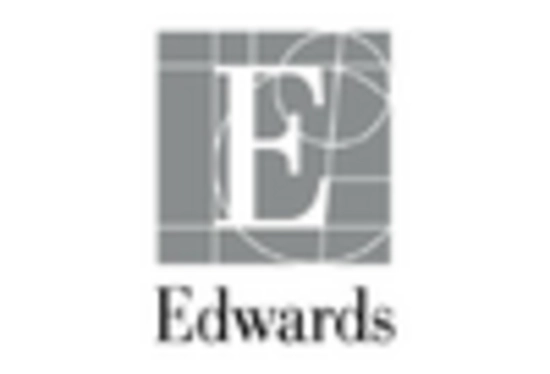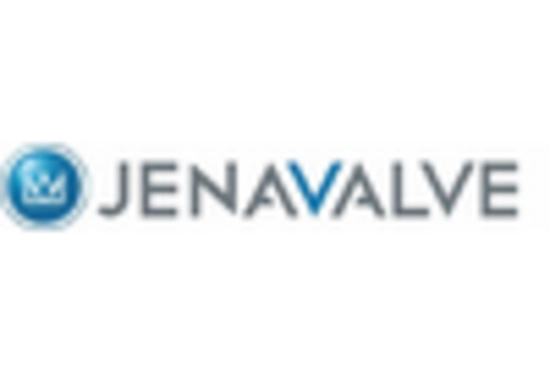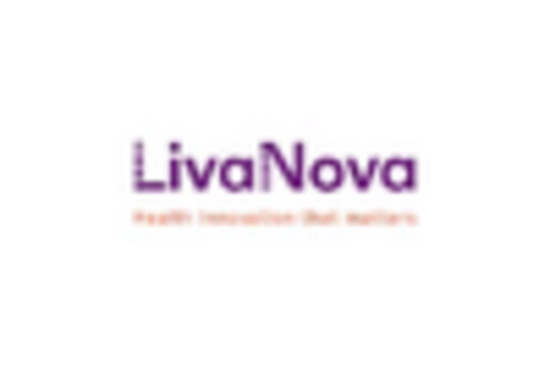Mechanical Valves
Bioprosthetic Valves
Transcatheter Valves
Aortic Valve Repair
Mitral Valve Repair
Tricuspid Valve Repair
Hospital
Ambulatory Surgical Centers
Cardiac Clinics
Biological Tissue
Synthetic Polymer
Metallic Alloys
North America
Europe
South America
Asia Pacific
Middle East and Africa
North America Outlook (USD Billion, 2019-2035)
North America Heart Valves Market by Type
Mechanical Valves
Bioprosthetic Valves
Transcatheter Valves
North America Heart Valves Market by Application Type
Aortic Valve Repair
Mitral Valve Repair
Tricuspid Valve Repair
North America Heart Valves Market by End Use Type
Hospital
Ambulatory Surgical Centers
Cardiac Clinics
North America Heart Valves Market by Material Type
Biological Tissue
Synthetic Polymer
Metallic Alloys
North America Heart Valves Market by Regional Type
US
Canada
US Outlook (USD Billion, 2019-2035)
US Heart Valves Market by Type
Mechanical Valves
Bioprosthetic Valves
Transcatheter Valves
US Heart Valves Market by Application Type
Aortic Valve Repair
Mitral Valve Repair
Tricuspid Valve Repair
US Heart Valves Market by End Use Type
Hospital
Ambulatory Surgical Centers
Cardiac Clinics
US Heart Valves Market by Material Type
Biological Tissue
Synthetic Polymer
Metallic Alloys
CANADA Outlook (USD Billion, 2019-2035)
CANADA Heart Valves Market by Type
Mechanical Valves
Bioprosthetic Valves
Transcatheter Valves
CANADA Heart Valves Market by Application Type
Aortic Valve Repair
Mitral Valve Repair
Tricuspid Valve Repair
CANADA Heart Valves Market by End Use Type
Hospital
Ambulatory Surgical Centers
Cardiac Clinics
CANADA Heart Valves Market by Material Type
Biological Tissue
Synthetic Polymer
Metallic Alloys
Europe Outlook (USD Billion, 2019-2035)
Europe Heart Valves Market by Type
Mechanical Valves
Bioprosthetic Valves
Transcatheter Valves
Europe Heart Valves Market by Application Type
Aortic Valve Repair
Mitral Valve Repair
Tricuspid Valve Repair
Europe Heart Valves Market by End Use Type
Hospital
Ambulatory Surgical Centers
Cardiac Clinics
Europe Heart Valves Market by Material Type
Biological Tissue
Synthetic Polymer
Metallic Alloys
Europe Heart Valves Market by Regional Type
Germany
UK
France
Russia
Italy
Spain
Rest of Europe
GERMANY Outlook (USD Billion, 2019-2035)
GERMANY Heart Valves Market by Type
Mechanical Valves
Bioprosthetic Valves
Transcatheter Valves
GERMANY Heart Valves Market by Application Type
Aortic Valve Repair
Mitral Valve Repair
Tricuspid Valve Repair
GERMANY Heart Valves Market by End Use Type
Hospital
Ambulatory Surgical Centers
Cardiac Clinics
GERMANY Heart Valves Market by Material Type
Biological Tissue
Synthetic Polymer
Metallic Alloys
UK Outlook (USD Billion, 2019-2035)
UK Heart Valves Market by Type
Mechanical Valves
Bioprosthetic Valves
Transcatheter Valves
UK Heart Valves Market by Application Type
Aortic Valve Repair
Mitral Valve Repair
Tricuspid Valve Repair
UK Heart Valves Market by End Use Type
Hospital
Ambulatory Surgical Centers
Cardiac Clinics
UK Heart Valves Market by Material Type
Biological Tissue
Synthetic Polymer
Metallic Alloys
FRANCE Outlook (USD Billion, 2019-2035)
FRANCE Heart Valves Market by Type
Mechanical Valves
Bioprosthetic Valves
Transcatheter Valves
FRANCE Heart Valves Market by Application Type
Aortic Valve Repair
Mitral Valve Repair
Tricuspid Valve Repair
FRANCE Heart Valves Market by End Use Type
Hospital
Ambulatory Surgical Centers
Cardiac Clinics
FRANCE Heart Valves Market by Material Type
Biological Tissue
Synthetic Polymer
Metallic Alloys
RUSSIA Outlook (USD Billion, 2019-2035)
RUSSIA Heart Valves Market by Type
Mechanical Valves
Bioprosthetic Valves
Transcatheter Valves
RUSSIA Heart Valves Market by Application Type
Aortic Valve Repair
Mitral Valve Repair
Tricuspid Valve Repair
RUSSIA Heart Valves Market by End Use Type
Hospital
Ambulatory Surgical Centers
Cardiac Clinics
RUSSIA Heart Valves Market by Material Type
Biological Tissue
Synthetic Polymer
Metallic Alloys
ITALY Outlook (USD Billion, 2019-2035)
ITALY Heart Valves Market by Type
Mechanical Valves
Bioprosthetic Valves
Transcatheter Valves
ITALY Heart Valves Market by Application Type
Aortic Valve Repair
Mitral Valve Repair
Tricuspid Valve Repair
ITALY Heart Valves Market by End Use Type
Hospital
Ambulatory Surgical Centers
Cardiac Clinics
ITALY Heart Valves Market by Material Type
Biological Tissue
Synthetic Polymer
Metallic Alloys
SPAIN Outlook (USD Billion, 2019-2035)
SPAIN Heart Valves Market by Type
Mechanical Valves
Bioprosthetic Valves
Transcatheter Valves
SPAIN Heart Valves Market by Application Type
Aortic Valve Repair
Mitral Valve Repair
Tricuspid Valve Repair
SPAIN Heart Valves Market by End Use Type
Hospital
Ambulatory Surgical Centers
Cardiac Clinics
SPAIN Heart Valves Market by Material Type
Biological Tissue
Synthetic Polymer
Metallic Alloys
REST OF EUROPE Outlook (USD Billion, 2019-2035)
REST OF EUROPE Heart Valves Market by Type
Mechanical Valves
Bioprosthetic Valves
Transcatheter Valves
REST OF EUROPE Heart Valves Market by Application Type
Aortic Valve Repair
Mitral Valve Repair
Tricuspid Valve Repair
REST OF EUROPE Heart Valves Market by End Use Type
Hospital
Ambulatory Surgical Centers
Cardiac Clinics
REST OF EUROPE Heart Valves Market by Material Type
Biological Tissue
Synthetic Polymer
Metallic Alloys
APAC Outlook (USD Billion, 2019-2035)
APAC Heart Valves Market by Type
Mechanical Valves
Bioprosthetic Valves
Transcatheter Valves
APAC Heart Valves Market by Application Type
Aortic Valve Repair
Mitral Valve Repair
Tricuspid Valve Repair
APAC Heart Valves Market by End Use Type
Hospital
Ambulatory Surgical Centers
Cardiac Clinics
APAC Heart Valves Market by Material Type
Biological Tissue
Synthetic Polymer
Metallic Alloys
APAC Heart Valves Market by Regional Type
China
India
Japan
South Korea
Malaysia
Thailand
Indonesia
Rest of APAC
CHINA Outlook (USD Billion, 2019-2035)
CHINA Heart Valves Market by Type
Mechanical Valves
Bioprosthetic Valves
Transcatheter Valves
CHINA Heart Valves Market by Application Type
Aortic Valve Repair
Mitral Valve Repair
Tricuspid Valve Repair
CHINA Heart Valves Market by End Use Type
Hospital
Ambulatory Surgical Centers
Cardiac Clinics
CHINA Heart Valves Market by Material Type
Biological Tissue
Synthetic Polymer
Metallic Alloys
INDIA Outlook (USD Billion, 2019-2035)
INDIA Heart Valves Market by Type
Mechanical Valves
Bioprosthetic Valves
Transcatheter Valves
INDIA Heart Valves Market by Application Type
Aortic Valve Repair
Mitral Valve Repair
Tricuspid Valve Repair
INDIA Heart Valves Market by End Use Type
Hospital
Ambulatory Surgical Centers
Cardiac Clinics
INDIA Heart Valves Market by Material Type
Biological Tissue
Synthetic Polymer
Metallic Alloys
JAPAN Outlook (USD Billion, 2019-2035)
JAPAN Heart Valves Market by Type
Mechanical Valves
Bioprosthetic Valves
Transcatheter Valves
JAPAN Heart Valves Market by Application Type
Aortic Valve Repair
Mitral Valve Repair
Tricuspid Valve Repair
JAPAN Heart Valves Market by End Use Type
Hospital
Ambulatory Surgical Centers
Cardiac Clinics
JAPAN Heart Valves Market by Material Type
Biological Tissue
Synthetic Polymer
Metallic Alloys
SOUTH KOREA Outlook (USD Billion, 2019-2035)
SOUTH KOREA Heart Valves Market by Type
Mechanical Valves
Bioprosthetic Valves
Transcatheter Valves
SOUTH KOREA Heart Valves Market by Application Type
Aortic Valve Repair
Mitral Valve Repair
Tricuspid Valve Repair
SOUTH KOREA Heart Valves Market by End Use Type
Hospital
Ambulatory Surgical Centers
Cardiac Clinics
SOUTH KOREA Heart Valves Market by Material Type
Biological Tissue
Synthetic Polymer
Metallic Alloys
MALAYSIA Outlook (USD Billion, 2019-2035)
MALAYSIA Heart Valves Market by Type
Mechanical Valves
Bioprosthetic Valves
Transcatheter Valves
MALAYSIA Heart Valves Market by Application Type
Aortic Valve Repair
Mitral Valve Repair
Tricuspid Valve Repair
MALAYSIA Heart Valves Market by End Use Type
Hospital
Ambulatory Surgical Centers
Cardiac Clinics
MALAYSIA Heart Valves Market by Material Type
Biological Tissue
Synthetic Polymer
Metallic Alloys
THAILAND Outlook (USD Billion, 2019-2035)
THAILAND Heart Valves Market by Type
Mechanical Valves
Bioprosthetic Valves
Transcatheter Valves
THAILAND Heart Valves Market by Application Type
Aortic Valve Repair
Mitral Valve Repair
Tricuspid Valve Repair
THAILAND Heart Valves Market by End Use Type
Hospital
Ambulatory Surgical Centers
Cardiac Clinics
THAILAND Heart Valves Market by Material Type
Biological Tissue
Synthetic Polymer
Metallic Alloys
INDONESIA Outlook (USD Billion, 2019-2035)
INDONESIA Heart Valves Market by Type
Mechanical Valves
Bioprosthetic Valves
Transcatheter Valves
INDONESIA Heart Valves Market by Application Type
Aortic Valve Repair
Mitral Valve Repair
Tricuspid Valve Repair
INDONESIA Heart Valves Market by End Use Type
Hospital
Ambulatory Surgical Centers
Cardiac Clinics
INDONESIA Heart Valves Market by Material Type
Biological Tissue
Synthetic Polymer
Metallic Alloys
REST OF APAC Outlook (USD Billion, 2019-2035)
REST OF APAC Heart Valves Market by Type
Mechanical Valves
Bioprosthetic Valves
Transcatheter Valves
REST OF APAC Heart Valves Market by Application Type
Aortic Valve Repair
Mitral Valve Repair
Tricuspid Valve Repair
REST OF APAC Heart Valves Market by End Use Type
Hospital
Ambulatory Surgical Centers
Cardiac Clinics
REST OF APAC Heart Valves Market by Material Type
Biological Tissue
Synthetic Polymer
Metallic Alloys
South America Outlook (USD Billion, 2019-2035)
South America Heart Valves Market by Type
Mechanical Valves
Bioprosthetic Valves
Transcatheter Valves
South America Heart Valves Market by Application Type
Aortic Valve Repair
Mitral Valve Repair
Tricuspid Valve Repair
South America Heart Valves Market by End Use Type
Hospital
Ambulatory Surgical Centers
Cardiac Clinics
South America Heart Valves Market by Material Type
Biological Tissue
Synthetic Polymer
Metallic Alloys
South America Heart Valves Market by Regional Type
Brazil
Mexico
Argentina
Rest of South America
BRAZIL Outlook (USD Billion, 2019-2035)
BRAZIL Heart Valves Market by Type
Mechanical Valves
Bioprosthetic Valves
Transcatheter Valves
BRAZIL Heart Valves Market by Application Type
Aortic Valve Repair
Mitral Valve Repair
Tricuspid Valve Repair
BRAZIL Heart Valves Market by End Use Type
Hospital
Ambulatory Surgical Centers
Cardiac Clinics
BRAZIL Heart Valves Market by Material Type
Biological Tissue
Synthetic Polymer
Metallic Alloys
MEXICO Outlook (USD Billion, 2019-2035)
MEXICO Heart Valves Market by Type
Mechanical Valves
Bioprosthetic Valves
Transcatheter Valves
MEXICO Heart Valves Market by Application Type
Aortic Valve Repair
Mitral Valve Repair
Tricuspid Valve Repair
MEXICO Heart Valves Market by End Use Type
Hospital
Ambulatory Surgical Centers
Cardiac Clinics
MEXICO Heart Valves Market by Material Type
Biological Tissue
Synthetic Polymer
Metallic Alloys
ARGENTINA Outlook (USD Billion, 2019-2035)
ARGENTINA Heart Valves Market by Type
Mechanical Valves
Bioprosthetic Valves
Transcatheter Valves
ARGENTINA Heart Valves Market by Application Type
Aortic Valve Repair
Mitral Valve Repair
Tricuspid Valve Repair
ARGENTINA Heart Valves Market by End Use Type
Hospital
Ambulatory Surgical Centers
Cardiac Clinics
ARGENTINA Heart Valves Market by Material Type
Biological Tissue
Synthetic Polymer
Metallic Alloys
REST OF SOUTH AMERICA Outlook (USD Billion, 2019-2035)
REST OF SOUTH AMERICA Heart Valves Market by Type
Mechanical Valves
Bioprosthetic Valves
Transcatheter Valves
REST OF SOUTH AMERICA Heart Valves Market by Application Type
Aortic Valve Repair
Mitral Valve Repair
Tricuspid Valve Repair
REST OF SOUTH AMERICA Heart Valves Market by End Use Type
Hospital
Ambulatory Surgical Centers
Cardiac Clinics
REST OF SOUTH AMERICA Heart Valves Market by Material Type
Biological Tissue
Synthetic Polymer
Metallic Alloys
MEA Outlook (USD Billion, 2019-2035)
MEA Heart Valves Market by Type
Mechanical Valves
Bioprosthetic Valves
Transcatheter Valves
MEA Heart Valves Market by Application Type
Aortic Valve Repair
Mitral Valve Repair
Tricuspid Valve Repair
MEA Heart Valves Market by End Use Type
Hospital
Ambulatory Surgical Centers
Cardiac Clinics
MEA Heart Valves Market by Material Type
Biological Tissue
Synthetic Polymer
Metallic Alloys
MEA Heart Valves Market by Regional Type
GCC Countries
South Africa
Rest of MEA
GCC COUNTRIES Outlook (USD Billion, 2019-2035)
GCC COUNTRIES Heart Valves Market by Type
Mechanical Valves
Bioprosthetic Valves
Transcatheter Valves
GCC COUNTRIES Heart Valves Market by Application Type
Aortic Valve Repair
Mitral Valve Repair
Tricuspid Valve Repair
GCC COUNTRIES Heart Valves Market by End Use Type
Hospital
Ambulatory Surgical Centers
Cardiac Clinics
GCC COUNTRIES Heart Valves Market by Material Type
Biological Tissue
Synthetic Polymer
Metallic Alloys
SOUTH AFRICA Outlook (USD Billion, 2019-2035)
SOUTH AFRICA Heart Valves Market by Type
Mechanical Valves
Bioprosthetic Valves
Transcatheter Valves
SOUTH AFRICA Heart Valves Market by Application Type
Aortic Valve Repair
Mitral Valve Repair
Tricuspid Valve Repair
SOUTH AFRICA Heart Valves Market by End Use Type
Hospital
Ambulatory Surgical Centers
Cardiac Clinics
SOUTH AFRICA Heart Valves Market by Material Type
Biological Tissue
Synthetic Polymer
Metallic Alloys
REST OF MEA Outlook (USD Billion, 2019-2035)
REST OF MEA Heart Valves Market by Type
Mechanical Valves
Bioprosthetic Valves
Transcatheter Valves
REST OF MEA Heart Valves Market by Application Type
Aortic Valve Repair
Mitral Valve Repair
Tricuspid Valve Repair
REST OF MEA Heart Valves Market by End Use Type
Hospital
Ambulatory Surgical Centers
Cardiac Clinics
REST OF MEA Heart Valves Market by Material Type
Biological Tissue
Synthetic Polymer
Metallic Alloys

















Leave a Comment